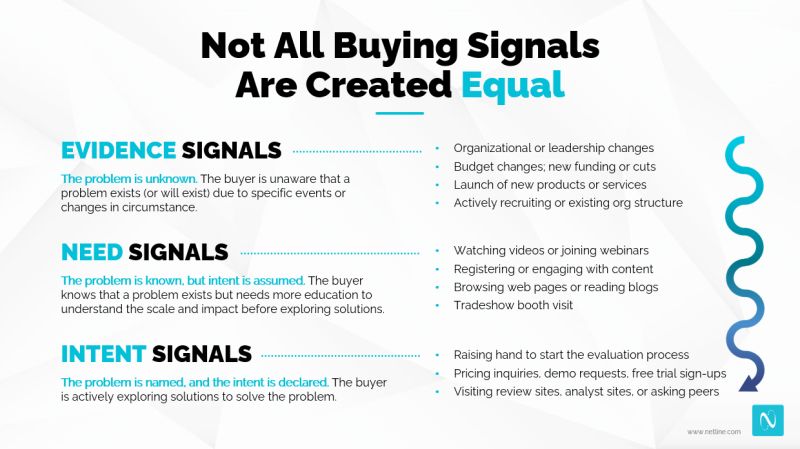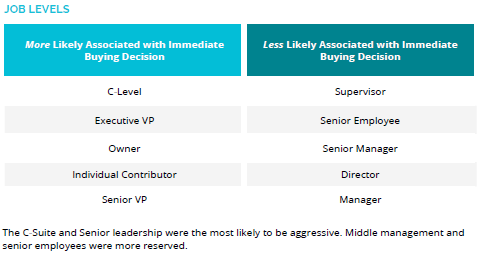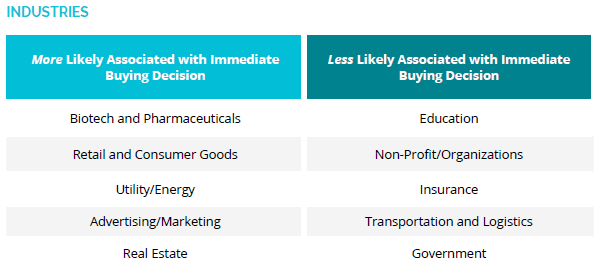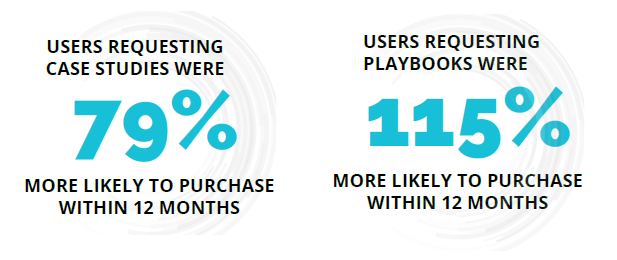Welcome back to our Summer Series on B2B Content Strategy.
In our first installment, we explored the importance of How Studying B2B Content Consumption Patterns Can Drive 2024 Success.
Today, we take the next step. Let’s focus on a critical element that will significantly affect everything in your business: artificial intelligence intent data.
Intent Data is the Hot New Thing
This may come as a surprise to some.
Before 2024, however, intent data struggled to resonate. For years, intent solutions delivered underwhelming results, leaving paying customers to question its validity and use case.
When NetLine introduced INTENTIVE in June 2023 at Forrester’s B2B Summit, interest was limited among attendees. Most were focused exclusively on AI.
Yet, by Forrester 2024, the market had matured. Demand for intent data surged, with attendees eager to learn more.
Why the shift?
Because B2B professionals realized that account-level data, alone, can’t cut it.
But intent data isn’t just about capturing actions—it’s about understanding them.
Intent Data Without Context is Useless
Matt Heinz is a respected figure in B2B marketing. He is also a good friend of NetLine.
We’ve spoken to him many times on the subject of intent data in 2024. Each time, he emphasizes that “intent-driven demand seems to be all the rage right now.”
He highlights that while intent data can significantly enhance lead quality, marketers must understand the context behind the data.
Simply knowing that a prospect is researching a topic isn’t enough; understanding their stage in the buying process and their specific needs is what truly drives successful engagement.
Why the Application of Intent Data Matters
There is a significant gap between possessing intent data and effectively utilizing it to drive business outcomes.
Heinz has quite a bit of frustration with the way intent data is currently used.
“What frustrates me most about intent data right now is that a lot of people have it but very few people are using it. So many companies have access to or have a repository of intent data but don’t have the process and playbooks to put it into motion.”
Separating the Serious From the Curious
Ultimately, this is why intent data matters.
Businesses and prospective buyers don’t want to waste time or energy on a relationship with no future.
By leveraging intent data, marketers can ensure they target the right prospects at the right time with the right message.
Tools like NetLine’s INTENTIVE provide real-time insights into who is showing intent, what they are interested in, and when they are most engaged.
This allows you to tailor your outreach and content to address the specific needs and interests of these high-intent prospects.
Referencing Forrester for the last time, this section’s sub-header was uttered by an intrigued booth visitor during a demo of our intent solution.
“So, essentially, INTENTIVE allows you to separate the serious from the curious?”
My ears perked up instantly. That was precisely correct, I told the gentleman.
(I also told him that I would 100% be stealing his perfect quote.)
With all of this in mind, let’s review what NetLine discovered about B2B professionals thanks to INTENTIVE.
Understanding Who’s Ready to Buy
Studying buyer-level intent signals can feel like a sneak peek into a prospect’s preferences.
It’s somewhat like having a good idea of where the ball might go on the next play or anticipating what your date might order at a restaurant.
However, it’s important to remember that needs can change, and even the strongest signals don’t guarantee a prospect is ready to buy.”
Data like this can revolutionize your selling motion.
Let’s dive into how Job Levels, Job Areas, and Industries influence purchase readiness.
Here’s a deep dive based on the report’s findings from pages 23-25.
How Demographics Influence Purchase Readiness
By addressing the specific needs of Job Levels, Job Areas, and Industries, you increase your chances to enhance engagement, build trust, and drive higher conversion rates.
A truly targeted approach ensures your content is relevant and impactful, leading to more effective marketing strategies and better business outcomes.
What we learned about intent by analyzing Job Levels
It would be safe to assume the following regarding content consumption: the more senior a professional is, the more seriously we should take their intent to purchase.
Senior professionals, especially executives, show higher purchase readiness. They have more on their plate, more experience, and greater influence. They’re the decision-makers who can greenlight a purchase quickly.
As shown in the table above, the spectrum of intent is quite interesting.
Professionals indicating greater purchase intent are either junior (we’re assuming that the majority of Individual Contributors are either entry-level professionals) or senior while those in middle management indicate lesser purchase intent.
Therefore, we can presume that while middle management consumes the most content, their overall influence over purchases is limited.
Intent Data Helps You Craft The Right Message
Buyer-level intent data can help you tailor your messaging to address strategic concerns for anyone. For example, let’s hone in on the needs of executives:
- Identify which professionals within an account demonstrate both the greatest engagement and highest purchase intent.
- Review content requests by format and timeline
- Review subject matter
- Develop content that speaks to the high-level concerns and strategic needs of senior executives.
- Focus on creating high-impact, concise content like executive summaries and strategic reports that cater to their need for quick, informed decision-making.
- Remember: Executives are just like the rest of us when it comes to information; the simpler the better.
- Provide insights and data that help executives make informed decisions swiftly.
- Refer to their consumption behaviors…but don’t be too precise
- There’s a fine line you don’t want to cross with these messages, lest you be thought of as… creepy.
What we learned about intent by analyzing Job Areas
The nature of your job—whether in marketing, IT, or finance—can shape how engaged you are with your work.
For instance, manufacturing and Human Resources departments will vary in their engagement levels.
Manufacturing professionals are constantly looking for ways to improve production efficiency and reduce costs, while Human Resources is likely reviewing ways to improve employee engagement tools.
Each department is busy—but it’s more likely that those in Manufacturing roles will be consuming more consistently than their HR peers.
Customize your content for each area to enhance relevance and impact.
Let’s stick with these two Job Areas in our examples.
What Manufacturing Job Areas Need
- Provide detailed eBooks on the latest production technologies and guides on implementing lean manufacturing practices.
- Offer interactive webinars on supply chain optimization and hands-on tutorials for new manufacturing software tools.
What Human Resources Job Areas Need
- Produce eBooks on innovative employee engagement strategies and what it takes to build a strong company culture and guides for implementing data-driven HR processes to improve overall workforce productivity.
- Write case studies on successful retention programs using the latest HR tech solutions.
What we learned about intent by analyzing Industries
Different industries have unique consumption patterns. Each industry has its pain points and opportunities—target these to maximize your reach.
Tech will always be a frontrunner. But two industries that should not be overlooked are Biotech and Manufacturing. Each area has seen steady growth in the past half-decade.
Biotech and Pharmaceuticals
- Content Focus: Emphasize innovation in drug development, regulatory compliance, and advancements in medical technology.
- Insight: Demand for AI-related content in the healthcare sector, including Biotech and Pharmaceuticals, grew significantly, highlighting the industry’s interest in integrating AI into their processes.
Advertising/Marketing
- Content Focus: Focus on digital marketing strategies, consumer behavior analytics, and innovative advertising techniques.
- Insight: The advertising and marketing sector saw a substantial increase in content consumption, with a significant interest in data-driven marketing strategies.
Actionable Tips for Industry-Specific Content
- Create in-depth whitepapers on emerging trends and regulatory updates.
- Develop interactive webinars and eBooks tailored to industry-specific challenges.
- Produce case studies showcasing successful implementations and strategies.
Consumption Probability and Purchase Intent
Higher consumption is often directly correlated to greater purchase intent.
This isn’t just a nice-to-know fact—it’s a call to action.
Pages 31-34 of the report reveal a goldmine of information on how content consumption correlates with purchase intent.
Key Findings
Frequent content consumption is a strong indicator of purchase readiness. It’s not just about getting eyes on your content; it’s about ensuring your content is valuable and engaging.
Actionable Insights
Focus on producing high-quality content that addresses the pain points of your audience. When your content resonates, it doesn’t just inform—it converts.
- High-Quality Content: Invest in producing content that offers real value, such as detailed guides, in-depth case studies, and interactive webinars.
- Engagement Tracking: Monitor which types of content drive the most engagement and refine your strategy accordingly.
Don’t Overlook the Importance of Intent Sequences
Tracking intent sequences offers a deeper understanding of how prospects navigate their content journey. Pages 35-36 emphasize how these sequences can predict future behaviors and inform your strategy.
User Progression from eBooks
Imagine tracking how users engage with your eBooks. It’s not just about the initial download—what comes next? By following their journey, you can predict and influence their next steps.
- Engagement Tracking: Use tools to follow how users move from eBook downloads to other actions, like webinar registrations or case study requests.
- Predictive Analysis: Analyze these sequences to forecast future behaviors and tailor your follow-up strategies accordingly.
Strategic Implementation
B2B marketers and sellers need to pay close attention to intent sequences. These insights help tailor your strategies, making your marketing efforts more effective and your sales processes smoother.
- Customized Follow-Ups: Develop follow-up strategies based on user engagement patterns to guide them through the funnel more effectively.
- Future Behavior Prediction: Use historical data to predict future actions and prepare your strategies accordingly.
Crafting Tailored Content
Personalization is no longer optional—it’s a necessity.
For years, the term personalization felt like lip service; often used but holding little to no weight.
Intent data, specifically buyer-level intent, enables true personalization—allowing the word to live up to its hype.
There are three basic steps to addressing your prospect’s unique challenges.
|
Tailored content strategies aligned with the buyer’s journey can significantly boost engagement.
Imagine speaking directly to someone’s needs instead of shouting into the void, hoping it resonates. How novel!
| “Give me six hours to chop down a tree and I will spend the first four sharpening the ax.” – Abraham Lincoln |
In an era where ROI and privacy are paramount, precise buyer-level intent data has become table stakes, underscoring its newfound importance.
Much like Lincoln’s ax metaphor, spending the necessary time to refine your approach and strategy with intent data before executing your plan of action ensures that your efforts are more focused and effective.
One of the most significant advantages of intent data is its ability to help marketers identify high-intent leads. These are prospects who are actively researching solutions and are more likely to convert into customers.
By focusing on these leads, you can prioritize your marketing efforts and resources more effectively, much like spending time sharpening the ax before chopping down the tree.
Recommended Approach: Establish a Playbook
| “Before anything else, preparation is the key to success.” – Alexander Graham Bell |
Intent data is meaningless without a plan of action.
Pages 34-36 underline the importance of having detailed processes and playbooks. These pages highlight the need to pay close attention to which content format your prospects engage with (and when).
For example, Courses are popular as a second registration choice. However, Courses don’t typically indicate purchase intent. Case Studies, despite being the least requested format (at 0.1% of second registration choices), represent a strong intent signal, with users being 78.5% more likely to make a purchase decision within 12 months, second only to Playbooks (+115%).
While the volume of Case Studies may be low, the prospects interested in them are highly likely to convert.
Imagine if you had a single playbook for each content type. You’d be wasting your time with a Course user when you could have prioritized the Case Study registrant.
Without a roadmap, even the best data can lead you astray.
Your sales and marketing teams, quite literally, need to be on the same page.
- Process Documentation: Create detailed guides for how sales and marketing teams should utilize intent data.
- Training: Regularly train teams on interpreting and acting on intent data insights.
- Alignment Meetings: Hold frequent alignment meetings to ensure both teams are synchronized in their approach.
Key Takeaway: How B2B Marketers Can Leverage Buyer-Level Intent Data
- Invest in Personalization
- Use intent data to craft highly personalized content that speaks directly to your audience’s needs. Personalization is no longer optional; it’s a necessity for driving engagement.
- Align Sales and Marketing
- Ensure both teams are following the same playbook. Alignment is key to maximizing impact. Regular alignment meetings and shared KPIs can help keep both teams on track.
- Emphasize Quality Over Quantity
- Produce fewer but higher-quality content pieces. Build trust and authority, which leads to conversions. High-quality content is more likely to engage and convert high-intent leads.
- Continuous Improvement
- Regularly review and refine your intent data strategies. Stay ahead of trends and adapt continuously. Use feedback and performance data to make informed adjustments to your approach.
Don’t Just Follow the Data—Lead with It
NetLine’s 2024 Report isn’t just a collection of data—it’s a strategic playbook. By focusing on high-intent leads, personalizing content, and aligning your sales and marketing efforts, you can drive greater engagement and achieve better business outcomes. As Matt Heinz aptly puts it, “It’s about using the data to inform your strategy, not dictate it.”
Stay tuned for our next installment, where we’ll dive into actionable tips for optimizing your content distribution strategy.






